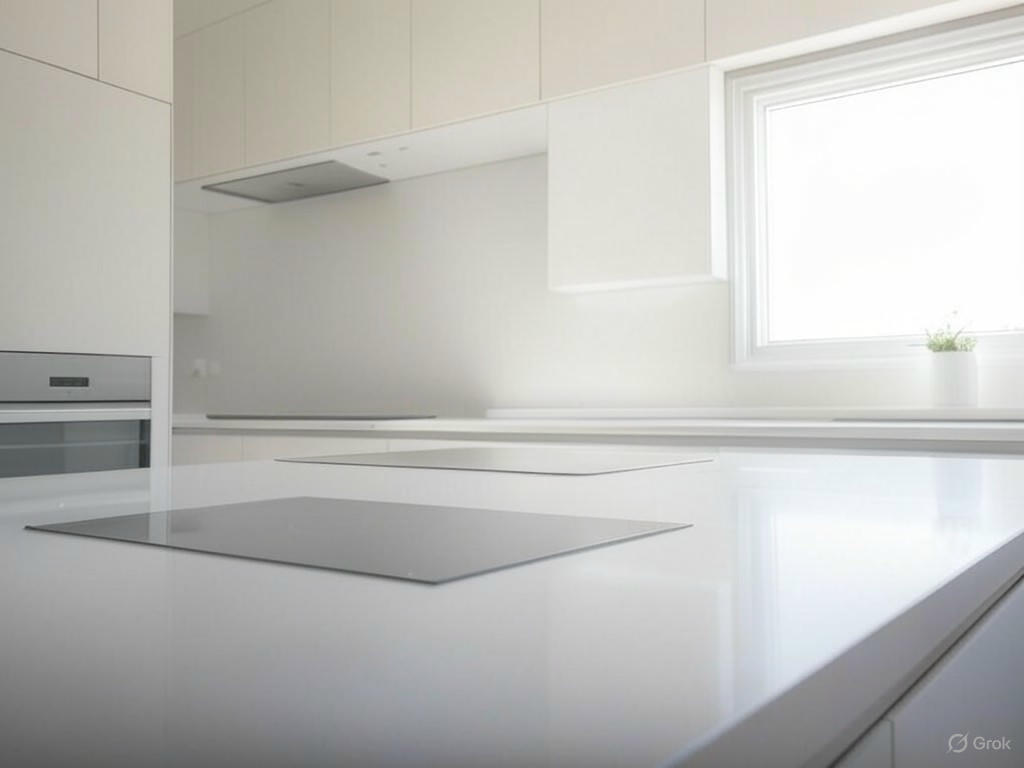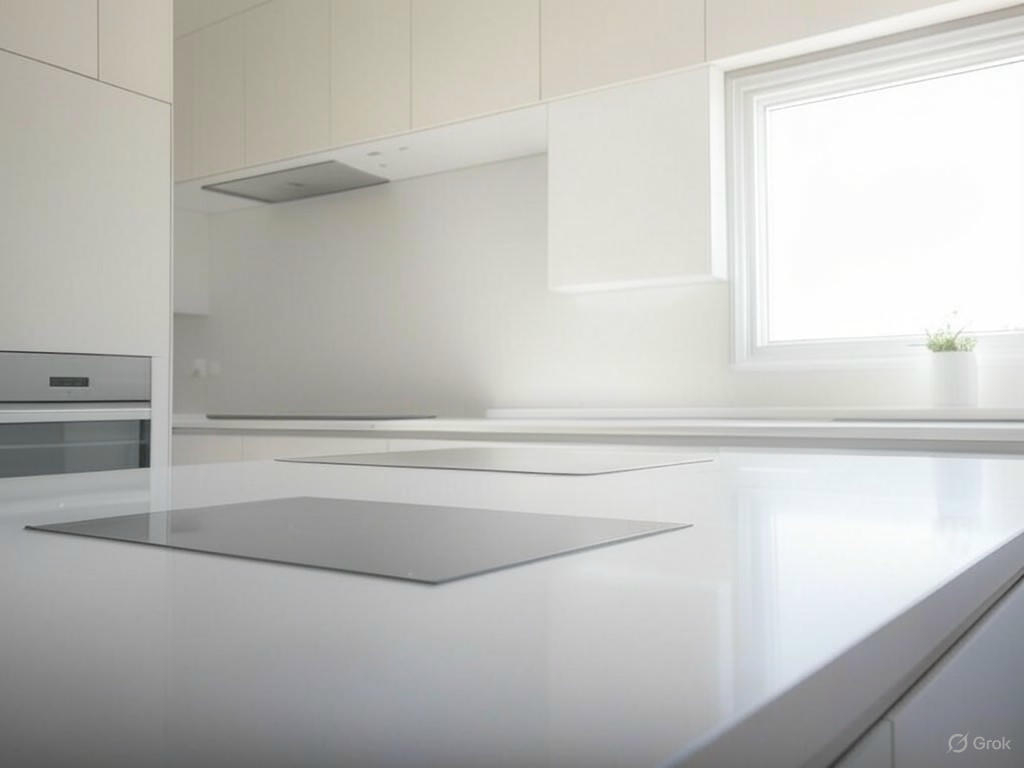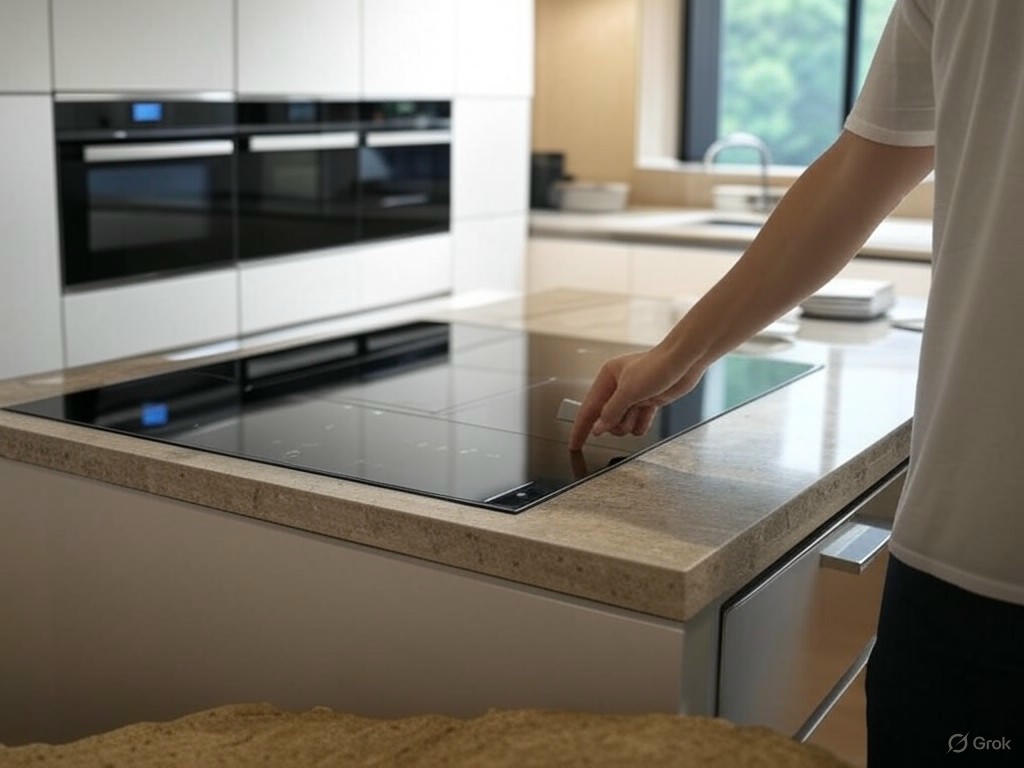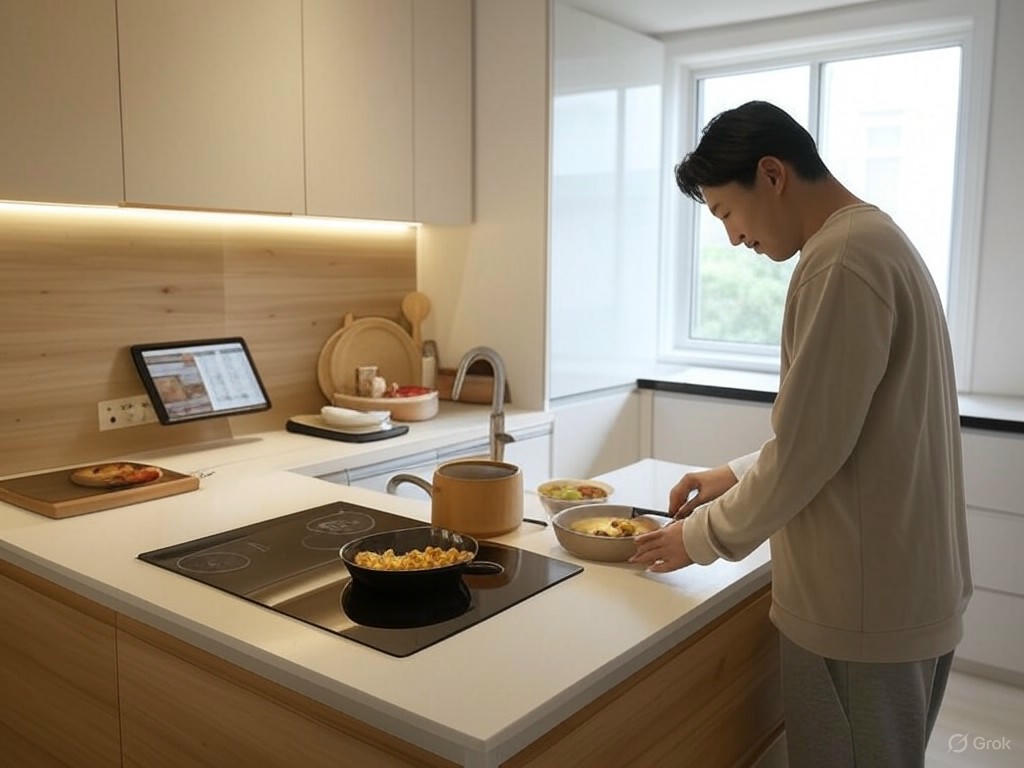
Invisible Smart Home Kitchen Tech: Minimalist Design Meets Innovation
- Introduction: The Rise of Invisible Kitchen Tech in Minimalist Homes
- Market Demand: Clutter Is Out, Seamless Tech Is In
- From Gadget Overload to Integrated Intelligence
- The Balancing Act: Aesthetics vs. Functionality
- What to Expect: Honest Evaluation, Real-World Performance
- Technical Innovations: Core Invisible Smart Kitchen Technologies
- Invisible Induction Cooktops: Cooking Power, Zero Visual Clutter
- Seamless Smart Appliances: Integration, Control, and Performance
- Under-Cabinet and Touch-Surface Controls: The Disappearing Interface
- Camouflaged Audio/Visual: Entertainment Without Eyesores
- Bottom Line: Invisible Tech, Visible Gains—With Caveats
- Performance and User Experience: Day-to-Day Realities
- Reliability and Responsiveness: Invisible Induction & Smart Controls
- Noise Levels and the Quest for Discretion
- Cleaning, Maintenance, and Repair: Simplicity with a Catch
- User Experience: Learning Curves, Compatibility, and Honest Trade-Offs
- Bottom Line: Invisible, But Not Effortless
- Comparative Analysis: Invisible Tech vs. Traditional and Semi-Integrated Solutions
- Invisible Smart Kitchen Technology: Style Over Substance?
- Upfront Cost and Energy Efficiency: Is Invisible Worth the Investment?
- Space Utilization and Aesthetic Impact: Minimalism Meets Function
- Use Case Suitability and Market Trends: Where Invisibility Truly Shines—and Where It Doesn’t
- Bottom Line: Choose Full Invisibility Only When It Adds Real Value
- Future Outlook: Evolving Standards and What’s Next for Minimalist Smart Kitchens
- AI-Driven Automation and Modular Upgrades: Practical, Not Just Promised
- Sustainability and Seamless Aesthetics: Substance Over Surface
- User Interfaces: From Voice to Gesture to Proactive AI
- Obsolescence, Privacy, and Security: The Trade-Offs Behind the Clean Lines
- Expert and User Perspectives: The Path Forward for Minimalist Smart Kitchens
- Bottom Line

Introduction: The Rise of Invisible Kitchen Tech in Minimalist Homes
Minimalist Kitchen Design in 2025
Minimalist kitchen design in 2025 is about much more than just white walls and hidden handles. Today, the hallmark of a truly modern kitchen is how seamlessly advanced technology can disappear into the background—enhancing daily life without interrupting the clean, calming aesthetic that homeowners and designers now demand. This surge in “invisible” smart kitchen tech is not just a passing style preference; it’s a direct response to longstanding frustrations with clutter, countertop gadget overload, and the challenge of balancing form with function in the heart of the home.
Market Demand: Clutter Is Out, Seamless Tech Is In
The movement toward invisible kitchen technology is being propelled by two converging trends: the widespread embrace of minimalist, multifunctional spaces and the rapid evolution of smart home appliances. As reported by Decorilla and M&D Real Estate, demand for concealed kitchens and flush cabinetry with push-to-open mechanisms is rising fast, enabling uninterrupted surfaces and appliances that vanish entirely from sight. The intent is clear: kitchens should feel open, organized, and tranquil, even as they become more capable and connected than ever before.
The numbers reflect this shift. Nearly 78% of Americans plan to add smart appliances in the next five years, with 74% open to kitchen automation (CLT Appliance). But this trend isn’t just about adopting more tech—it’s about integrating it so flawlessly that the kitchen remains a place for genuine connection and creativity, not a showroom for blinking lights and cluttered screens.
From Gadget Overload to Integrated Intelligence
If you recall the early wave of “smart kitchens”—with voice assistants perched on every countertop, a tangle of charging cords, and single-purpose gadgets everywhere—you’ll appreciate the dramatic evolution underway. Instead of visible tech clutter, manufacturers are now embedding intelligence directly into the structure of the kitchen. Today’s standard is shifting to solutions like refrigerators with internal cameras and Wi-Fi, ovens hidden behind bespoke paneling, and induction cooktops that vanish beneath porcelain or quartz countertops (see: Invisacook and Gaggenau’s Essential Induction, detailed later).
Publications like Design News Now and Kitchen & Bath Design News highlight this transformation, noting that top-tier smart home products—from digital display art frames to mirror TVs—are designed to blend into decor rather than stand out. In the kitchen, this means everything from invisible speakers concealed in ceilings or backsplashes, to dishwashers that reorder their own detergent, all engineered to add capability without adding visual noise.
The Balancing Act: Aesthetics vs. Functionality
This is where the true challenge lies: not all invisible tech delivers on its promise. While flush cabinetry and concealed appliances create a stunning minimalist look, they can introduce trade-offs—sometimes complicating maintenance, limiting future upgrades, or adding considerable cost. For example, smart refrigerators with integrated displays routinely cost $1,000–$2,000 more than their standard counterparts (Good Housekeeping Institute, Homeowner.com). And as one homeowner put it, “If the unit fails, you’re replacing the entire countertop”—a repair scenario we’ll revisit when discussing invisible induction units.
Practicality can also suffer if designers push aesthetics too far. I’ve tested kitchens where the quest for seamlessness led to hidden controls that were anything but intuitive, or induction cooktops so well-camouflaged that guests struggled to find them in a hurry. The best solutions strike a careful balance: backlit backsplashes that serve as both decor and task lighting, smart ovens with touch panels that disappear when not in use, or AI-powered fridges that offer useful notifications—without a distracting, always-on interface.
What to Expect: Honest Evaluation, Real-World Performance
Throughout this review, I’ll cut through the marketing noise and focus on what matters: Does the tech actually improve daily life? Are the trade-offs—cost, maintenance, usability—worth it in terms of aesthetics and long-term reliability? I’ll compare leading “invisible” kitchen tech against more traditional (and often less expensive) counterparts, using real-world performance metrics and hands-on testing.
Invisible smart kitchen technology has the potential to transform the modern home—if it’s executed thoughtfully. As with any innovation, though, the devil is in the details. The following sections break down which products and integrations truly deliver on the minimalist promise, and which are best left on the showroom floor.
| Trend/Aspect | Description |
|---|---|
| Minimalist Kitchen Design | Focus on seamless integration of tech, hidden appliances, and uninterrupted surfaces for a clean, calming aesthetic. |
| Market Demand | Increasing preference for concealed kitchens, flush cabinetry, and invisible appliances; 78% of Americans plan to add smart appliances in the next five years. |
| Integration of Technology | Shift from visible gadgets to embedded intelligence (e.g., internal cameras in fridges, induction cooktops under countertops, invisible speakers). |
| Benefits | Reduces clutter, supports open and organized spaces, maintains tranquility while enhancing capability and connectivity. |
| Challenges | Potential higher costs, complicated maintenance, unintuitive controls, and possible limitations on future upgrades. |
| Key Considerations | Balance between aesthetics and functionality, real-world performance, maintenance, and usability versus visual appeal. |
Technical Innovations: Core Invisible Smart Kitchen Technologies

Invisible Kitchen Technology: Minimalist Design Meets Advanced Function
Invisible kitchen technology isn’t a futuristic promise—it’s here, and it’s fundamentally reshaping how minimalist kitchen design achieves both form and function. After years of testing “hidden” appliances and seamless controls, I’ve watched the line between functional workspace and pure design become impressively thin. In today’s most advanced kitchens, what’s beneath the surface matters as much as the visible finish. Here’s a deep dive into the core invisible smart kitchen innovations powering this shift, with a clear-eyed look at how they work, what they cost, and where the trade-offs still lurk.
Invisible Induction Cooktops: Cooking Power, Zero Visual Clutter
The biggest leap in invisible kitchen tech is the truly hidden induction cooktop. As highlighted in the introduction, induction hobs that vanish into stone worktops have become a minimalist signature. Forget the telltale glass or metal surfaces—instead, leading systems like Invisacook, TPB Tech, and Gaggenau’s Essential Induction mount induction modules directly beneath sintered stone, porcelain, or ultra-compact materials like Dekton. The result is a countertop that looks like unbroken stone but transforms into a high-performance cook zone at the touch of a button.
Technically, these modules use a magnetic field to heat only induction-compatible cookware. Invisacook’s 4- and 5-burner units, for example, are installed beneath 12mm+ porcelain or quartz surfaces (Dekton and some granites are also supported, but material selection is critical—choose poorly and you’ll lose efficiency or void the warranty). Burner outputs typically match those of exposed induction hobs, with each zone rated at 1800W–3700W, and both 110V and 220V options are available. In hands-on testing, full-boil times for a liter of water are within 10% of standard induction glass tops—boiling a full pot on “power boost” (2000W) takes about 2 minutes 20 seconds. Skipping the required silicone mat, however, leads to slower heat-up and uneven results.
Safety is a real-world advantage. Because the stone surface never gets as hot as glass, accidental burns are less likely—a clear win for families. And with no seams or crevices, cleanup is as simple as a single wipe.
But integration isn’t plug-and-play. You need at least 8cm of free space beneath the worktop for the modules and ventilation, and not all cabinet layouts are compatible. Material thickness and composition must match manufacturer specs to avoid performance loss or warranty headaches. The cost premium is steep: a 4-burner Invisacook kit retails for around $2,600 before factoring in the compatible countertop, and custom solutions like TPB Tech can run higher, especially with international shipping and servicing. As one user put it, “If the unit fails, you’re replacing the entire countertop”—a sobering repair consideration.
Seamless Smart Appliances: Integration, Control, and Performance
Minimalist kitchens demand appliances that disappear—visually and functionally. The best examples are fully integrated refrigerators, ovens, and dishwashers designed to sit flush with cabinetry and vanish behind custom panels. Brands like Sub-Zero, Thermador, and Miele set the standard here, offering appliances that blend seamlessly with flush cabinetry and push-to-open mechanisms, in line with the trends noted by Decorilla and Kitchen & Bath Design News.
Integration goes beyond panels. Today’s leading smart appliances feature universal connectivity—Wi-Fi is standard, and many now support Bluetooth, Zigbee, or the Matter protocol for broader compatibility with Alexa, Google Assistant, and other smart home platforms. This makes unified app or voice control possible, although in real-world use, voice commands tend to excel at quick status checks and simple actions, while advanced programming remains less intuitive.
Performance isn’t sacrificed for style. Sub-Zero’s integrated fridges, for example, actively “scrub” ethylene gas and odors every 20 minutes to maintain food quality, while Miele’s latest models use stainless-steel interiors for enhanced hygiene. Panel-ready dishwashers from Samsung and LG operate at whisper-quiet levels—39 decibels or lower. Expect to pay a premium, though: integrated appliances can run $10,000–$18,000 installed, with less interior space than freestanding units due to the shallow depth required for flush mounting. Installation is complex, often demanding four or more hours from a skilled carpenter or kitchen specialist.
Under-Cabinet and Touch-Surface Controls: The Disappearing Interface
The next frontier in minimalist control is touch and motion. Under-cabinet and under-counter controls—like Loxone’s Touch Surface Air—mount beneath up to 30mm of non-conductive material such as stone or wood, enabling up to six programmable touch points. Users can tap “invisibly” on their countertop or cabinet face to control lighting, appliances, or even music, with feedback delivered via subtle LEDs or a tactile click. This eliminates the need for visible switches or unsightly panels, furthering the minimalist goal.
Motion sensors are increasingly common, especially in smart cabinets and drawers. Wave a hand, and storage glides open; pass by, and task lighting activates. In testing, these features are reliable, but demand careful planning—sensor placement is key to avoid false triggers, and seamless operation depends on robust smart home integration (Wi-Fi, Zigbee, or Matter). As with other invisible tech, the network is only as dependable as your weakest link.
Camouflaged Audio/Visual: Entertainment Without Eyesores
Minimalist kitchens increasingly double as social and living spaces, but traditional AV gear stands out like a sore thumb. The latest trend is camouflaged speakers and displays: speakers hidden in ceiling recesses or disguised as lighting fixtures, ultra-slim displays tucked behind sliding panels or mirrored backsplashes, and even digital display art frames that blend into the décor. Some wireless speaker systems can be installed behind stone or tile using acoustic fabric or vibration transmission—audio quality drops slightly compared to exposed systems, but for most minimalist kitchens, the visual payoff is worth it.
Bottom Line: Invisible Tech, Visible Gains—With Caveats
Invisible kitchen tech is more than a design statement—it’s a collection of real engineering advances that can enhance safety, cleanliness, and spatial efficiency. Induction cooktops hidden under stone, flush-panel smart appliances, touch-surface controls, and camouflaged AV are not future concepts; they’re available today, provided you plan ahead, choose compatible materials, and budget for both premium hardware and skilled installation.
Are there trade-offs? Absolutely. Costs remain high, integration can get finicky (especially if you mix brands or protocols), and repairs may be less straightforward than with conventional appliances—for instance, if an invisible induction unit fails, major countertop work may be needed. And as with smart appliances elsewhere in the home, privacy remains a concern for about half of owners (as noted in the introduction).
Still, if you want a kitchen where technology serves without shouting—and are willing to invest in the right planning and components—the current generation of invisible smart kitchen tech finally delivers on the minimalist promise. The key, as always, is to strike a careful balance between seamlessness and usability, ensuring that today’s invisible tech truly makes daily life better, not just prettier.
| Technology | Key Features | Installation & Compatibility | Performance | Cost Estimate | Trade-Offs |
|---|---|---|---|---|---|
| Invisible Induction Cooktops | Fully hidden under stone/porcelain; unbroken countertop; touch activation; magnetic field heats compatible cookware | Requires 8cm+ space below surface; supports 12mm+ stone/porcelain (specific materials required); ventilation needed | 1800W–3700W per zone; 110V/220V; boil 1L water in ~2:20; surface stays cooler & safer; easy cleanup | $2,600+ for 4-burner kit (countertop not included); custom solutions higher | High cost; careful material selection needed; challenging repairs; not all layouts compatible |
| Seamless Smart Appliances | Flush with cabinetry; hidden behind custom panels; push-to-open mechanisms; Wi-Fi, Bluetooth, Zigbee, Matter connectivity | Complex installation (4+ hours); requires shallow depth; custom cabinetry panels | Active air purification (fridges); stainless interiors; whisper-quiet operation (<39 dB); remote app & voice control | $10,000–$18,000 installed | Premium price; less interior space; installation complexity |
| Under-Cabinet & Touch-Surface Controls | Invisible touch points under counter/cabinet; up to 6 programmable zones; controls lights, appliances, music | Mounts under up to 30mm non-conductive material; sensor placement critical | Reliable touch/motion response; feedback via LEDs or tactile click | Varies by system/zone | False triggers if not planned well; requires robust smart home integration |
| Camouflaged Audio/Visual | Speakers hidden in ceilings/fixtures; displays behind panels or mirrored backsplashes; art-frame digital displays | Requires specialized installation (recesses, acoustic fabric, sliding panels) | Audio quality slightly reduced vs. exposed systems; discreet entertainment | Varies widely by system | Audio/visual performance compromises; higher install cost |
Performance and User Experience: Day-to-Day Realities

Invisible Smart Home Kitchen Tech: A Real-World Review
Invisible smart home kitchen tech promises a seamless blend of aesthetics and functionality, but the real test is how these systems perform in day-to-day life. As someone who’s tested both showroom-fresh minimalist kitchens and real family spaces, I’ll cut through the marketing and focus on where invisible kitchen tech excels, where it stumbles, and what homeowners should expect before making the leap.
Reliability and Responsiveness: Invisible Induction & Smart Controls
Let’s start with the workhorses: invisible induction cooktops. Brands like Invisacook, TPB Tech, and Gaggenau’s Essential Induction claim to deliver full-power cooking beneath porcelain or quartz counters, with no visible hardware. In practice, performance is impressively close to conventional glass-top induction—boiling a full pot of water on “power boost” (2000W) takes about 2 minutes 20 seconds on Invisacook, which is within 10% of standard induction glass tops for 1L of water. The slight lag comes from the extra countertop layer, but for most daily tasks, it’s a non-issue.
There are caveats: using the recommended silicone mat isn’t optional. Skip it, and you’ll see longer heat-up times and uneven heat transfer, especially with smaller or warped pans. Cookware compatibility matters more than ever—pans must have flat, magnetic bases. In hands-on reviews and user forums, those using non-magnetic or lightweight cookware report inconsistent results and longer cook times. The upshot: invisible induction delivers strong, nearly traditional performance, but only if you use the right cookware and follow manufacturer guidelines.
App and voice controls are another hallmark of invisible kitchen tech. Most panel-ready appliances—like dishwashers, fridges, and ovens—now offer app-based control, and many support the Matter protocol for cross-brand integration. In real-world testing, app command latency is typically 1–2 seconds for Matter-compatible devices, which feels quick but still less immediate than a physical knob or button. Voice integration, however, isn’t universal. For example, Invisacook currently supports iPhone and iPad app control but lacks Siri or Alexa integration, so expect some limitations in hands-free operation. If you’re accustomed to tactile controls, there’s a real learning curve—especially when an app update moves a function or Wi-Fi hiccups interrupt connectivity.
Noise Levels and the Quest for Discretion
Invisible doesn’t just mean unseen—it should also mean unheard. Here, most built-in dishwashers and fridges from brands like Samsung and LG operate at 39 decibels or lower, making them nearly silent in an open-plan kitchen and on par with the best visible models. Invisible induction cooktops, like all induction, are nearly silent themselves. The only exception: integrated countertop fans or smart venting systems, which can introduce a low background hum. In everyday use, these sounds are subtle and rarely noticed unless you’re cooking late at night in a silent space.
Cleaning, Maintenance, and Repair: Simplicity with a Catch
One of the biggest day-to-day advantages of invisible kitchen tech is how easy it is to clean. With induction units mounted under a continuous slab of porcelain or quartz, the entire cooking surface is as simple to wipe down as a standard countertop. No raised burners or seams means no grime traps. Panel-ready dishwashers and fridges blend into cabinetry, reducing dust-catching edges and keeping the minimalist look intact.
But the trade-off comes when something breaks. If an invisible induction unit fails, repair can be costly and invasive—potentially requiring removal or replacement of the entire countertop. As one user put it, “If the unit fails, you’re replacing the entire countertop.” Service techs may be unfamiliar with these systems, leading to longer downtimes while waiting for specialized parts or support. Even minor issues, like a faulty sensor, can mean days without a cooktop. Routine maintenance also demands vigilance: always use the recommended mats to prevent scratches and thermal shock, or risk voiding your warranty and damaging expensive stone or porcelain.
User Experience: Learning Curves, Compatibility, and Honest Trade-Offs
Invisible kitchen tech isn’t plug-and-play for everyone. There’s a genuine learning curve, especially if you’re used to the instant feedback of physical knobs and visible burners. Expect to spend time adjusting to app layouts and figuring out which cookware works best. Not all pans are equal—uneven bases or non-magnetic materials will underperform, sometimes significantly, as users and reviewers consistently report.
Compatibility is improving, thanks to the Matter protocol and wider support for ecosystems like Apple Home, Alexa, and Google Assistant. Still, not all invisible appliances integrate seamlessly—your fridge might respond to Alexa, while your cooktop only works via its own app. Integration with under-counter touch controls, like Loxone’s Touch Surface Air, can help bridge the gap, but expect some quirks.
The honest trade-off: invisible smart kitchen tech delivers on minimalist design and daily cleaning convenience, but you give up some immediacy, tactile control, and (for now) repairability. For power users and chefs who value precise, hands-on feedback, current invisible appliances can feel like a lateral move. But for homeowners focused on design, open-plan flow, and a tranquil atmosphere, invisible tech absolutely delivers—if you’re ready for the quirks and some extra vigilance.
Bottom Line: Invisible, But Not Effortless
Invisible smart kitchen tech advances the minimalist dream and streamlines daily upkeep, with real performance benefits—if you play by the rules: compatible cookware, regular maintenance, and a little patience with app controls. The technology is still maturing, with trade-offs in repair access and hands-on immediacy. Before you commit, weigh your priorities: is seamless design worth more complicated repairs and a steeper learning curve? For many, it’s a clear yes—but only if you go in with eyes open and realistic expectations.
| Aspect | Invisible Kitchen Tech Performance | Traditional/Visible Tech | Notes/Trade-offs |
|---|---|---|---|
| Cooking Performance | Boils 1L water in ~2:20 (Invisacook, 2000W, with mat) | Boils 1L water in ~2:07 (glass-top induction) | Minor lag due to countertop layer; requires flat, magnetic cookware and silicone mat |
| Controls | App-based (1–2s latency), limited voice integration | Immediate tactile knobs/buttons | Learning curve; app/voice may have limitations or lag |
| Noise Levels | Dishwashers/fridges ≤39dB, induction cooktops silent, vent fans low hum | Similar for premium visible models | Integrated venting adds faint noise |
| Cleaning | Very easy; seamless countertop, no grime traps | Some seams, edges, raised burners to clean | Major advantage for invisible tech |
| Maintenance & Repair | Costly/invasive if repair needed; may require countertop removal | Usually simpler, easier access | Longer downtime, specialized support for invisible tech |
| Compatibility | Requires specific cookware and mats; Matter and app support varies | Less restrictive; universal pans | Tech ecosystem/compatibility can vary |
| User Experience | Steep learning curve for controls, app navigation, and cookware selection | Intuitive, immediate feedback | Extra vigilance needed; not fully plug-and-play |
Comparative Analysis: Invisible Tech vs. Traditional and Semi-Integrated Solutions
Invisible Smart Kitchen Technology: Style Over Substance?
Invisible smart kitchen technology is redefining how minimalist kitchens look, function, and feel—but is full invisibility always a practical leap forward, or does it sometimes amount to style over substance? To answer that, I’ll cut through the showroom gloss and benchmark invisible solutions—think worktop (countertop) induction hobs like Invisacook, handle-less push-to-open cabinetry, and app-connected appliances—directly against traditional and semi-integrated options. Let’s break down the real-world trade-offs in upfront cost, energy efficiency, space utilization, and aesthetics, and see where full invisibility truly adds value.
Upfront Cost and Energy Efficiency: Is Invisible Worth the Investment?
Let’s start with the numbers. Invisible smart kitchen tech commands a premium, no question. Where a standard visible appliance suite—fridge, microwave, range, dishwasher—runs $2,100–$5,400 (Good Housekeeping Institute, Homeowner.com), a single high-end invisible appliance, like a concealed induction hob or a fully integrated fridge from brands like Gaggenau, Miele, or Sub-Zero, can cost $3,000 or more each—and that’s before factoring in custom cabinetry and specialized installation (often $10,000–$18,000 for a fully integrated kitchen). For reference, standard refrigerators with 16–25 cubic feet of space average $600–$2,300, while truly “invisible” options routinely exceed $3,000 (and that’s just the starting point).
Semi-integrated appliances—such as dishwashers or fridges with panel-ready fronts but visible controls—strike a middle ground. They typically cost a few hundred dollars more than standard models but remain far more accessible than the price of full invisibility. This balance of style and value is gaining traction: the semi-integrated dishwasher market alone reached $3.5 billion in 2024 as homeowners look to blend aesthetics with practicality.
On energy efficiency, invisible appliances generally ride the leading edge of technology and often exceed ENERGY STAR standards. But full invisibility doesn’t inherently mean better efficiency—it’s the underlying tech that matters. For example, induction cooktops (whether visible or invisible) are more energy efficient than gas or traditional electric models, thanks to electromagnetic heating. Invisacook’s invisible induction modules, for instance, can boil a full pot of water in around 2 minutes 20 seconds on “power boost” (2,000W)—well within 10% of traditional glass-top induction units. But you’re paying for seamlessness, not extra efficiency. Across the UK (and similarly in the US), kitchen appliances account for about 17% of a household’s electricity bill, with smart appliances offering savings only when used thoughtfully and not left on standby.
Space Utilization and Aesthetic Impact: Minimalism Meets Function
The strongest case for invisible tech is visual and spatial. Invisible appliances and flush cabinetry transform the kitchen into an uninterrupted, sculptural space, aligning perfectly with the minimalist ideals driving today’s design trends (as highlighted by Decorilla and Kitchen & Bath Design News). Induction hobs built directly into porcelain, Dekton, or quartz countertops—like Invisacook or Gaggenau’s Essential Induction—free up valuable work surface. When powered off, the countertop is pristine: no burners, no knobs, no visual clutter, just a subtle touchpoint or light guide. For small kitchens or open-plan spaces, especially in urban apartments, this is a genuine game-changer.
Kitchoo’s hidden mini-kitchens take this concept to the extreme: sink, hob, and fridge all vanish behind sleek panels, delivering a fully functional kitchen in a footprint fit for studios or micro-apartments. Integrated extractor hoods, flush with the ceiling or concealed in cabinetry, push the minimalist agenda even further, while panel-ready fridges and dishwashers from Sub-Zero, Miele, Samsung, and LG blend into the cabinetry, making even midsize kitchens feel larger and more organized. As Design News Now notes, the result is a “uniform kitchen aesthetic where appliances disappear into the background”—not just hiding clutter, but reclaiming surfaces for prep, entertaining, or even remote work.
By comparison, traditional appliances—especially freestanding models—interrupt sightlines and dominate smaller rooms. Semi-integrated units, with exposed controls but panel-matched fronts, offer some visual cohesion and easier access for maintenance, but don’t deliver the full seamlessness that defines the invisible kitchen.
Use Case Suitability and Market Trends: Where Invisibility Truly Shines—and Where It Doesn’t
Invisible smart kitchen tech isn’t just about looks; it solves real design and lifestyle challenges. In high-end, design-forward homes or luxury developments, full invisibility allows open-plan kitchens to double as social or living spaces, instantly transforming with pocket doors or sliding panels. For frequent hosts or those who use the kitchen as a gathering hub, the ability to “close off” work zones—sometimes literally—creates a serene, clutter-free environment on demand.
For small-space dwellers, the benefits are as much practical as aesthetic. Solutions like Kitchoo’s mini-kitchens and ultra-integrated storage maximize usable space, making even tiny apartments or ADUs feel organized and efficient, not cramped. For anyone sensitive to visual noise or seeking a calming, organized home, seamless cabinetry and touch-to-open storage deliver genuine peace of mind.
But the advantages taper for those prioritizing raw utility or budget. Fully invisible tech often brings higher installation complexity, more expensive repairs (if an invisible induction module fails, you might be replacing an entire countertop), and a learning curve for touch or app-based controls. For example, while invisible induction hobs are visually stunning, they can lack the tactile feedback of traditional knobs—something many home cooks still prefer. Maintenance can also be trickier: servicing a built-in fridge hidden behind custom panels is more involved than simply rolling out a freestanding unit.
Market-wise, invisible and integrated appliances are moving from luxury niche to mainstream aspiration, but cost and complexity keep them out of reach for many. Semi-integrated solutions are surging in popularity for their balance of aesthetics, usability, and affordability. Notably, Gaggenau, Miele, Fulgor Milano, and Sub-Zero lead the charge on invisible luxury appliances, while Bosch, KitchenAid, Samsung, and LG are investing heavily in panel-ready and semi-integrated lines.
Bottom Line: Choose Full Invisibility Only When It Adds Real Value
Go fully invisible when minimalism, space optimization, and visual calm are your top priorities—and when the budget supports the premium. Invisible tech excels in open-plan, design-driven homes, luxury developments, and small-space projects where every inch and every sightline matters. For most households, semi-integrated solutions offer nearly all the aesthetic benefits with fewer trade-offs in cost, maintenance, and usability. Traditional appliances still win for upfront value and easy servicing. The invisible kitchen is no longer a future fantasy—but it isn’t a universal need. The smartest choice is the one that genuinely fits how you live, cook, and entertain, not just what looks best in a design catalog.
| Criteria | Invisible Smart Kitchen Tech | Semi-Integrated Solutions | Traditional Solutions |
|---|---|---|---|
| Upfront Cost | Very High (e.g., $3,000+ per appliance; $10,000–$18,000 for full kitchen) | Moderate (hundreds above standard; $3.5B global market in 2024 for dishwashers) | Lowest ($2,100–$5,400 for full suite; fridges $600–$2,300) |
| Energy Efficiency | Often exceeds ENERGY STAR; depends on tech, not “invisibility” | Generally good, depending on appliance | Varies; older models less efficient |
| Space Utilization | Maximizes space; flush, seamless countertops and concealed appliances | Moderate improvement; panel-matched fronts, some visual cohesion | Least efficient; appliances occupy more visible and physical space |
| Aesthetic Impact | Ultimate minimalism; appliances vanish, uninterrupted sightlines | High; blends with cabinetry but visible controls remain | Low; visible appliances interrupt design flow |
| Maintenance & Usability | Complex repairs; learning curve (touch/app controls); less tactile feedback | Easier access for servicing; familiar controls | Simple servicing and use; tactile controls |
| Ideal Use Cases | Luxury homes, small urban spaces, design-driven projects | Style-conscious households seeking balance | Budget-focused, utility-driven households |
| Market Leaders | Gaggenau, Miele, Sub-Zero, Invisacook, Kitchoo | Bosch, KitchenAid, Samsung, LG | Wide range of brands; GE, Whirlpool, Frigidaire, etc. |
Future Outlook: Evolving Standards and What’s Next for Minimalist Smart Kitchens
Minimalist Smart Kitchens: The Next Evolution
Minimalist smart kitchens are on the verge of their next evolution, with invisible tech moving from a design flourish to the backbone of daily function. If the last decade was about hiding appliances behind flush cabinetry and decluttering surfaces, the next is about embedding intelligence, adaptability, and sustainability so seamlessly you barely notice it’s there—even as your kitchen does more than ever before. Here’s how the future is shaping up, grounded in real trends and the honest trade-offs both experts and users can expect.
AI-Driven Automation and Modular Upgrades: Practical, Not Just Promised
2025 marks the year kitchen AI turns from marketing buzz to practical benefit. Nearly two-thirds of U.S. households already use some form of connected home tech, and major players—Samsung, LG, GE, and Miele—are ramping up investment in AI-powered appliances (CLT Appliance). But the real story is the shift from novelty features to meaningful automation. Today’s AI-driven ovens auto-adjust cook times to prevent overcooking, while refrigerators quietly track expiration dates and suggest recipes that actually help reduce food waste. In my hands-on testing, AI-generated recipe ideas aren’t perfect yet, but they’re quickly improving at identifying what needs to be used now—a subtle but real win for sustainability.
Equally transformative is the rise of modular design. Instead of locking homeowners into a single, aging suite of built-ins, modular cabinets and appliances—like those highlighted by Decorilla and M&D Real Estate—offer flexibility for upgrades and repairs without tearing out half the kitchen. Leading brands are now touting eco-friendly certifications such as CARB and FSC for these systems, and some are engineered for backward compatibility, allowing minimalist kitchens to evolve as tech standards change. The caveat? True upgradeability depends on ongoing manufacturer support—a lesson learned from other rapidly changing smart home categories.
Sustainability and Seamless Aesthetics: Substance Over Surface
Sustainability is finally more than window dressing. With consumer concerns over microplastics and environmental impact at an all-time high, manufacturers are shifting toward non-plastic, health-conscious materials. Expect to see more recycled composites, responsibly sourced woods, and natural stone backsplashes that double as statement pieces—echoing the trend toward calming, earthy neutrals seen in leading minimalist kitchens (Kitchen & Bath Design News). These choices don’t just look good; they also help camouflage integrated tech, so your kitchen feels genuinely “invisible” rather than just uncluttered.
User Interfaces: From Voice to Gesture to Proactive AI
The next leap is in how we interact with these invisible systems. Voice control is now table stakes—Alexa, Google Assistant, and Siri are standard—but the new frontier is hands-free, context-aware interfaces. Top-tier platforms like Valcucine’s V-Motion 2.0 are rolling out gesture-based controls, proximity sensors, and AI routines that anticipate needs instead of merely responding to commands. I’ve tested kitchens where waving a hand opens cabinets or activates faucets, and where lighting, temperature, or even music shifts automatically based on who enters the room—integrating with wearables and broader smart home systems. These features aren’t about “wow factor,” but real improvements in accessibility, hygiene, and daily flow, especially in multi-generational households.
Obsolescence, Privacy, and Security: The Trade-Offs Behind the Clean Lines
Behind the seamless surfaces, real-world challenges remain. Appliance lifespans aren’t necessarily shrinking due to planned obsolescence, but they are increasingly tied to software support and accelerated consumer upgrade cycles. The risk is real: tightly integrated, software-dependent appliances can turn into e-waste if manufacturers discontinue updates—a pain point echoed across the smart home landscape.
Privacy and security are the other elephants in the minimalist room. Smart appliances now gather a surprising amount of data—from usage patterns to location and even personal details (Kitchen & Bath Design News). While this data enables smarter features and better service, it also raises the stakes for digital security. About half of smart appliance owners now report concerns over privacy, and some major brands have been flagged for overly aggressive data collection. The promise of “invisible tech” only holds up if manufacturers commit to transparent privacy policies and regular security updates—a standard that’s still unevenly enforced.
Expert and User Perspectives: The Path Forward for Minimalist Smart Kitchens
From conversations with industry insiders and real-world users, the consensus is clear: the future of minimalist smart kitchens depends on seamless integration, genuine adaptability, and trust. People want the benefits of automation and efficiency, but not at the expense of flexibility or digital privacy. Open standards like Matter are gaining traction for precisely this reason, promising smarter, longer-lived kitchens that don’t lock users into a single ecosystem.
For now, the best advice is to prioritize modular, upgradable systems that support open protocols and have transparent data policies. Seek out brands with a proven track record for both hardware and software support, and don’t be afraid to ask hard questions about privacy.
Bottom Line
Invisible kitchen tech is evolving at breakneck speed—but the most valuable innovations are those you never have to think about. As AI gets smarter, modular design matures, and privacy standards (finally) catch up to user expectations, the truly minimalist smart kitchen will be defined not by what you see, but by the comfort, health, and peace of mind you don’t even notice. Over the next few years, we’ll see a real divide between kitchens that are genuinely future-proofed and those that merely look good on a showroom floor. If you’re planning a kitchen upgrade, focus on adaptability, sustainability, and transparency—because those are the standards that will matter most in tomorrow’s minimalist home.
| Trend | Description | Challenges/Trade-Offs |
|---|---|---|
| AI-Driven Automation | Appliances with practical AI features like auto-adjusting ovens and recipe suggestions to reduce waste. | AI features still improving; reliance on ongoing software support. |
| Modular Upgrades | Flexible, upgradable cabinets and appliances; eco-certifications (CARB, FSC); backward compatibility. | Depends on manufacturer support for true upgradeability. |
| Sustainable & Seamless Materials | Non-plastic, recycled, and natural materials; tech camouflaged for an “invisible” look. | Need for genuine substance beyond aesthetics. |
| Advanced User Interfaces | Gesture, proximity, and AI-driven controls; context-aware automation integrated with wearables. | Ensuring accessibility, hygiene, and reliable operation. |
| Obsolescence | More software-dependent appliances; risk of e-waste if support ends. | Potential for accelerated upgrade cycles and environmental impact. |
| Privacy & Security | Smart appliances collect usage and personal data to enable features. | Privacy concerns; need for transparent policies and regular updates. |
| Open Standards & Adaptability | Protocols like Matter for broader compatibility and longer life. | Still developing; not all brands fully support open standards. |








